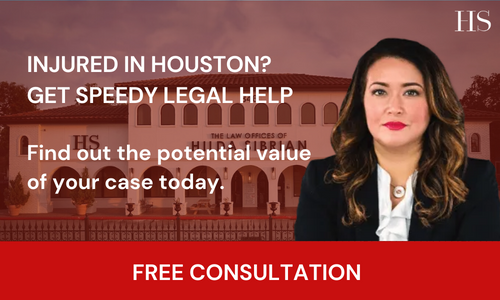In this blog, Hilda Sibrian® will share road safety secrets for you and your family. From the traffic jams on the Katy Freeway to the intricacies of the Loop, mastering the art of driving in Houston requires more than basic skills behind the wheel—it demands a keen understanding of the city’s road safety secrets.
First off, you must know that highway safety matters to us. If you face an accident, give us a call! We will seek justice on your behalf and your family’s. Call us now and book your free initial consultation at The Law Offices of Hilda Sibrian™.
TxDOT Measures for Traffic Safety
The Texas Department of Transportation (TxDOT) implements various measures and programs to enhance transportation safety across the state. Some of these measures include:
- Click It or Ticket: TxDOT promotes seat belt usage through its Click It or Ticket campaign, which aims to increase awareness and compliance with seat belt laws.
- Drive Clean Texas: This program focuses on reducing vehicle emissions and promoting clean air through vehicle emissions testing, anti-idling campaigns, and public education on vehicle maintenance.
- End the Streak: TxDOT’s End the Streak campaign aims to end the streak of daily deaths on Texas roadways. The program emphasizes safe driving practices and urges motorists to drive responsibly to reduce the number of traffic fatalities.
- Impaired Driving Initiatives: TxDOT works to enhance vehicle safety by reducing impaired driving through various initiatives, including public awareness campaigns, sobriety checkpoints, and enforcement of DUI laws.
- Share the Road: TxDOT encourages safe interactions between road users, including motorists, pedestrians, cyclists, and motorcyclists. The Share the Road program promotes awareness and mutual respect among all road users to prevent accidents and enhance pedestrian safety.
- Work Zone Safety: TxDOT prioritizes work zone safety to protect workers and motorists. The department implements measures such as reduced speed limits, signage, and public awareness campaigns to improve safety in work zones.
- Vision Zero: TxDOT supports the Vision Zero initiative, which aims to eliminate traffic fatalities and severe injuries on Texas roadways. The program focuses on improving road design, enhancing enforcement, and promoting safe driving behaviors to achieve its goal.
- Safe Routes to School: TxDOT’s Safe Routes to School program promotes walking and biking to school by implementing infrastructure improvements such as sidewalks, crosswalks, and bike lanes to enhance student safety.
Tips for A Safe Driving
Here are some tips for you to follow to avoid accidents on the road by our Houston Car Accident Lawyers:
- Stay focused: Pay full attention to the road and avoid distractions such as using your phone, eating, or adjusting controls while driving.
- Obey traffic laws: Follow speed limits, traffic signals, signs, and lane markings. These rules are in place to keep everyone safe.
- Keep a safe distance: Maintain a safe following distance between your vehicle and the one in front of you to allow for enough reaction time in case of sudden stops or emergencies.
- Avoid aggressive driving: Be patient and courteous to other drivers. Avoid tailgating, speeding, or weaving in and out of traffic.
- Use your seat belt: Always wear your seat belt and ensure that all passengers do the same. Seat belts save lives and reduce the risk of severe injuries in accidents.
- Be aware of your surroundings: Scan the road ahead, check your mirrors, and be mindful of vehicles around you. Anticipate potential hazards and adjust your driving accordingly.
- Avoid driving under the influence: Never drive while under the influence of alcohol, drugs, or medications that may impair your ability to drive safely. Use alternative transportation or designate a sober driver if you plan to drink.
- Watch for pedestrians and cyclists: Be attentive to pedestrians and cyclists, especially in urban areas and around crosswalks. Yield the right of way to them and give them plenty of space.
- Adapt to weather conditions: Adjust your driving behavior based on weather conditions like rain, snow, or fog. Reduce your speed, increase following distance, and use headlights as necessary for visibility.
- Maintain your vehicle: Regularly check and maintain it to ensure it is in good working condition. This includes checking tire pressure, brakes, lights, and fluid levels.
Road Accident Prevention: Most Transited Roads in Houston
Houston is a bustling metropolis with a complex network of roads and highways that serve as vital arteries for transportation. Some of the most heavily transited roads in Houston include:
- Interstate 610 (I-610): Also known as the “610 Loop,” this highway forms a loop around the central part of Houston. It is a primary connector to various neighborhoods, business districts, and other roads and experiences heavy daily traffic.
- Interstate 45 (I-45): I-45 is a crucial north-south interstate that runs through the heart of Houston, connecting it with other major cities like Dallas and Galveston. Portions of I-45 within Houston, especially downtown, are heavily congested during peak travel times.
- Interstate 10 (I-10): Also known as Katy Freeway, I-10 is a major east-west interstate traverses Houston, connecting it with cities like San Antonio and New Orleans. Portions of I-10 within Houston experience high traffic volumes, particularly during rush hours and peak travel times.
- U.S. Highway 59 (U.S. 59): U.S. 59, also known as the Southwest Freeway or the Eastex Freeway, depending on the segment, is a significant north-south highway that runs through Houston. It connects the city with nearby towns and suburbs like Sugar Land and Victoria.
- State Highway 288 (SH 288): SH 288 is a major highway that connects downtown Houston with the southern suburbs and communities such as Pearland and Lake Jackson. It is a vital commuter route and experiences heavy traffic, particularly during weekday rush hours.
- Beltway 8: Also known as the Sam Houston Tollway, Beltway 8 is a large loop that encircles much of the Greater Houston area. It provides a bypass route around the city and connects various suburbs, industrial areas, and airports. Different segments of Beltway 8 experience heavy traffic, especially during peak travel times.
These are just a few examples of the most transited roads in Houston. Still, many other major thoroughfares and highways within the city also experience significant traffic congestion.
Traffic Rules and Regulations You Should Know
It’s essential to stay informed about current laws and drive safely and responsibly on the roads. Here are some indispensable traffic rules and regulations that drivers in Texas should be aware of:
- Speed Limits: Observe posted speed limits on roads and highways. In Texas, speed limits can vary depending on the type of road, weather conditions, and other factors.
- Seat Belt Laws: Texas requires all vehicle occupants to wear seat belts. Drivers can be fined if passengers under 15 are not properly restrained.
- Driving Under the Influence (DUI): It is illegal to operate a motor vehicle while under the influence of alcohol or drugs in Texas. The legal blood alcohol concentration (BAC) limit is 0.08% for adults, and lower limits apply for drivers under 21.
- Right-of-Way: Drivers must yield the right-of-way to pedestrians in crosswalks and at intersections. When entering a roadway from a driveway or private road, yield to oncoming traffic.
- Traffic Signals and Signs: Obey traffic signals, stop signs, yield signs, and other regulatory signs. Failure to do so can result in traffic violations and accidents.
- School Zones: Reduce your speed and exercise extra caution when driving through school zones, especially when children arrive or leave school.
- Cell Phone Use: Texas law prohibits handheld cell phones while driving in school zones and for drivers under 18. Additionally, texting while driving is banned statewide for all drivers.
- Move Over Law: Texas has a Move Over/Slow Down law that requires drivers to move over or slow down when approaching emergency vehicles, tow trucks, or utility vehicles parked on the side of the road with their lights flashing.
- Registration and Insurance: Ensure your vehicle is registered and insured according to Texas law. Failure to provide proof of insurance or registration when requested by law enforcement can result in penalties.
The Law Offices of Hilda Sibrian™ Impulses Safe Roads in Texas
Road safety matters. Please drive home safely; your family awaits your arrival. If you are involved in a car accident in Houston, we will seek the justice you deserve! Call The Law Offices of Hilda Sibrian™ now to book your initial free consultation. Remember, we are friendly to you but aggressive to insurance companies.








